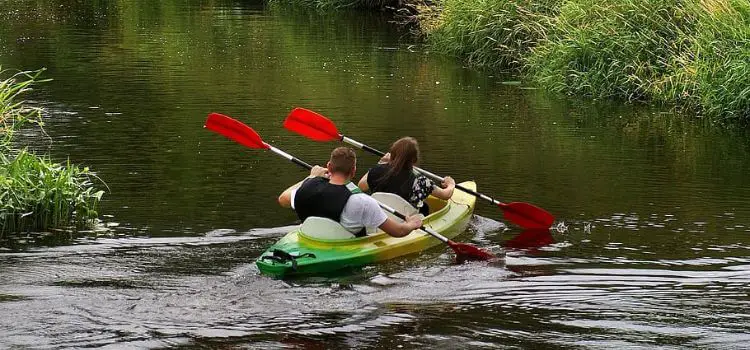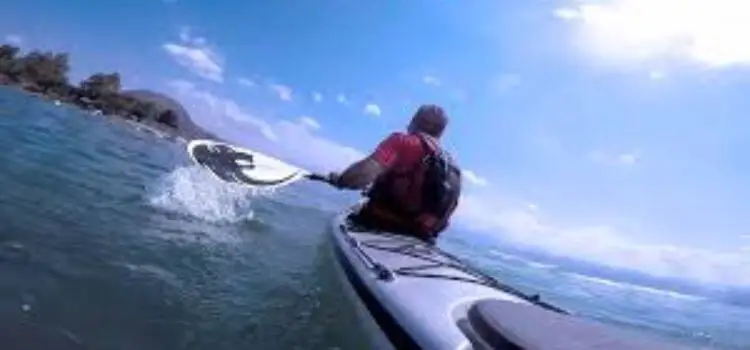As an Amazon Associates, I earn from quality purchases.
To excel as a kayaker, mastering efficient turns is essential. In this article, we provide valuable tips and techniques for improving your maneuverability on the waterways by learning how to turn in a kayak properly.
A proper understanding of paddle strokes and weight distribution constitutes the successful execution of turns. Sweep strokes coupled with edging and body rotation combine seamlessly for initiating as well as maintaining steady turns like an expert kayaker would do it!
Our guide caters to novices seeking guidance towards building strong foundations or experienced paddlers looking forward to further refinement of their skills with inspirational self-confidence heading towards progressing steadily forward.
Come with us and unlock new experiences by gracefully maneuvering through nature’s beauty. Let’s start the journey!
Understanding Kayak Dynamics

Before delving into the specific techniques for turning it is important to first gain a solid understanding of some basic principles of kayak maneuverability. Here are a few key factors to keep in mind:
1. Hull Shape:
The shape of your kayak’s hull can affect how well it turns. Kayaks with flat hulls tend to be more stable but have slower turns. Whereas kayaks with rounded or V-shaped hulls are more maneuverable and responsive.
2. Paddle Length:
The length of your paddle can also impact your ability to turn efficiently. Longer paddles provide more leverage for powerful strokes, which makes turning easier.
3. Body Positioning:
Proper body positioning plays a significant role in allowing for optimal kayak maneuverability. You need to be sure to maintain a relaxed grip on the paddle while executing smooth movements. It will help you to stay balanced and centered in your kayak
Getting Started: Proper Body Positioning
If you want to initiate a successful turn, you have to maintain a stable and balanced body position in the kayak. Follow these steps:
- Sit in an upright position with your back straight and your feet resting on the footpegs.
- Ensure your knees are slightly bent and in contact with the thigh braces.
- Keep your core engaged and maintain a relaxed grip on the paddle.
If you can adopt this posture, you’ll have better control over your kayak’s movements. It will make turning easier and more efficient for you.
The Forward Stroke: Foundation for Turning
Mastering the forward stroke is fundamental to executing a smooth turn. The forward stroke propels the kayak forward while setting the stage for turning. Follow these guidelines:
- Place the paddle blade fully in the water, near your feet.
- Rotate your torso and engage your core as you pull the paddle through the water.
- Maintain a consistent and fluid motion, focusing on transferring power from your core to the paddle.
A strong and efficient forward stroke will provide the necessary momentum for executing turns with ease.
Turning Techniques

Now that you understand the basics, let’s explore different turning techniques you can employ while kayaking.
1. Sweep Stroke
The sweep stroke is one of the fundamental techniques for turning a kayak. Follow these steps:
- Begin with a forward paddling motion, keeping your arms extended and the paddle blade near your toes.
- Rotate your torso and plant the paddle blade near the bow of the kayak.
- As you reach the midpoint of your kayak, sweep the paddle in a wide arc away from the kayak, using your torso rotation to generate power.
- Complete the stroke by bringing the paddle blade close to the stern of the kayak.
The sweep stroke helps you turn smoothly by creating a wide, sweeping motion that shifts the kayak’s direction.
2. Reverse Sweep Stroke
The reverse sweep stroke, also known as the stern rudder, enables you to execute quick and precise turns. Follow these steps:
- Place the paddle blade in the water behind your hip, angled toward the kayak’s bow.
- Initiate a sweeping motion, similar to the regular sweep stroke, but in the opposite direction.
- Engage your core and use your body’s rotation to enhance the turning effect.
The reverse sweep stroke is particularly useful when you need to make rapid turns or adjust your kayak’s direction swiftly.
3. Edging Technique
The edging technique involves tilting your kayak to one side by shifting your body weight. Here’s how to perform it effectively:
- Start by sitting upright in your kayak in a neutral position.
- Gradually lean your upper body and tilt the kayak to one side. This will raise the opposite edge of the kayak.
- Use your paddle to make small, controlled strokes on the opposite side of the kayak to enhance the turning motion.
- Practice edging on calm waters before attempting it in more challenging conditions.
The edging technique improves maneuverability by allowing you to use the kayak’s secondary stability and change direction swiftly.
4. Stern Rudder
The stern rudder technique is especially useful when you need to make sharp turns. Follow these steps:
- Begin by paddling forward at a moderate speed.
- Place the paddle blade vertically into the water near the stern of your kayak.
- Apply pressure against the water while keeping the paddle vertical. This creates resistance and turns the kayak.
- Maintain a relaxed grip and make adjustments as necessary to control the turn radius.
The stern rudder technique is effective for making quick turns in tight spaces and provides excellent control over your kayak’s direction.
5. Bow Draw
The bow draw technique is ideal for making precise turns while maintaining forward momentum. Here’s how to execute it:
- Initiate the turn by paddling forward with the blade placed near the bow of your kayak.
- Rotate your upper body and plant the paddle blade vertically into the water near the bow.
- Pull the paddle blade towards the kayak, using it as an anchor point.
- Simultaneously twist your torso and shift your weight to the opposite side of the kayak to enhance the turn.
The bow draw technique allows you to make controlled turns while keeping the kayak’s momentum, making it useful for navigating narrow channels or avoiding obstacles.
Safety Considerations
While mastering the art of turning in a kayak, it’s crucial to prioritize safety. Here are a few safety hacks to keep in mind:
- Always wear a properly fitted personal flotation device (PFD) when kayaking.
- Familiarize yourself with the water conditions, including currents, tides, and weather forecasts.
- Practice in calm and controlled environments before attempting more challenging maneuvers.
- Stay aware of your surroundings and be mindful of other watercraft, obstacles, and wildlife.
By adhering to these safety guidelines, you can enjoy the thrills of kayaking while minimizing the associated risks.
Practicing Turning Maneuvers
To improve your turning skills, it’s crucial to practice various turning maneuvers in different conditions. Start in calm waters and gradually progress to more challenging environments, such as rivers or ocean currents. Experiment with different strokes, body positions, and weight distributions to find what works best for you.
Tips for Turning Efficiency
To enhance your turning efficiency, consider the following tips:
- Relax your grip on the paddle and maintain a loose grip to allow for fluid movements.
- Engage your core muscles to generate power and stability during turns.
- Look in the direction you want to turn, as your body naturally follows your line of sight.
- Practice good posture by sitting upright and maintaining balance in your kayak.
- Regularly assess and adjust your body position, paddle strokes, and weight distribution to optimize your turns.
Conclusion
Congratulations! You’ve now learned the essential techniques for turning in a kayak. By mastering the sweep stroke, reverse sweep stroke, edging, and bow draw stroke, you can confidently navigate any waterway with precision and control. Remember to practice these techniques regularly to refine your skills and become a proficient kayaker.
So, grab your paddle, hit the water, and embark on thrilling adventures while exploring the world from your kayak’s perspective!
You may also read Are Kayaks Easy to Flip?
FAQs (Frequently Asked Questions)
1. How do you turn when kayaking?
To turn while kayaking, you can use techniques such as forward and reverse sweep strokes, edging, and body movements.
2. Is it easy to turn a kayak over?
The ease of turning a kayak over depends on factors like stability, skill level, and water conditions. Recreational kayaks are generally more stable.
3. How do you steer a sit-in kayak?
Steering a sit-in kayak involves forward paddling, using sweep strokes, and edging techniques.
4. How do you pivot turn a kayak?
To perform a pivot turn, stop or slow down, perform a forward sweep stroke on one side, and a reverse sweep stroke on the other while shifting weight and using body movements.
5. Can you turn around in a kayak?
Yes, you can turn around in a kayak using techniques like sweep strokes, edging, and draw strokes.
6. What are tips for turning a kayak effectively?
Tips include practicing proper paddle technique, engaging core muscles, maintaining momentum, anticipating turns, adjusting stroke intensity, and practicing in different conditions.
7. Can I turn a kayak without using a paddle?
Yes, you can use alternative methods such as body movements and weight shifting to turn a kayak without a paddle.

Leave a Reply